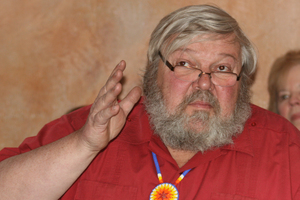Speaker tells of journey through charted territory

Chadron State College’s series of Lewis and Clark speakers continued Tuesday night with a presention by Dr. James Hanson. The Chadron historian made his presentation to a jam-packed audience of about 50 people in room 108 of the Reta King Library.
Hanson showed historical paintings of the characters associated with the journey and told stories and anecdotes about each. He said that many consider Lewis and Clark to be the first European explorers to cross North America, but noted that the territory had already been mapped by others before the 1804-1806 expedition.
Hanson said Alexander Mackenzie, a Canadian fur trader, is recognized as the first European to cross North America. Mackenzie first set out to find the Pacific Ocean in 1789, but took a wrong turn and found himself at the Arctic Ocean six months later. The explorer made it to the Pacific Coast of British Columbia on his second attempt, in 1792-93, after having traveled to Europe to study navigation and purchase instruments. He later published a book and map of his journey that became a bestseller in America.
“Everybody, including Thomas Jefferson, Meriwether Lewis and William Clark, read this book, so they all knew about him,” Hanson said.
Hanson also noted that the fur trade was well established by the time of Lewis and Clark’s journey. Hanson showed a map that featured about a dozen trading posts south of North Dakota along the Missouri River that predated the expedition.
“This was not an unknown territory that they were marching into,” he said. “In the first year, they were basically retracing what the fur traders had already studied.”
In addition to the historical paintings and maps, Hanson showed photos of cloth samples that Lewis and Clark had presented to the Indians. The samples are on display in Chadron’s Museum of the Fur Trade.
Hanson, who was director of the Nebraska State Historical Society 1985-1992, has authored more than 60 articles about various historical topics, including frontier material culture, American Indian-white relations, museum and collection conservation. He is known as an expert in evaluating and appraising commercially manufactured artifacts of the 17th-19th centuries, especially trade goods intended for sale to American Indians.
Hanson said the Lewis and Clark Expedition interests him because, “There is so much information available about it, yet so many unanswered questions.”
Hanson’s presentation was an installment of the Dorset Graves Lecture Series, which is focusing on Lewis and Clark this spring to coincide with a special exhibit in the library. Next up will be Kira Gale of Omaha, whose topic is “The Mysterious Death of Meriwether Lewis: Murder or Suicide?” Gale’s presentation will be on the second floor of the library at 2 p.m. Sunday, April 6.
Category: Campus News
